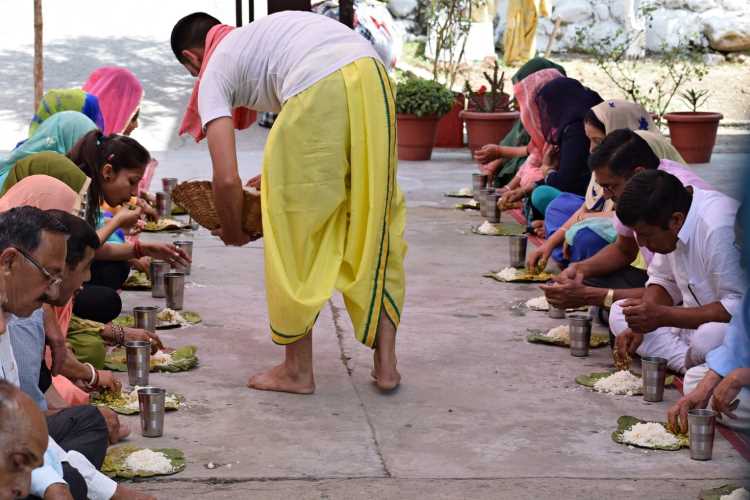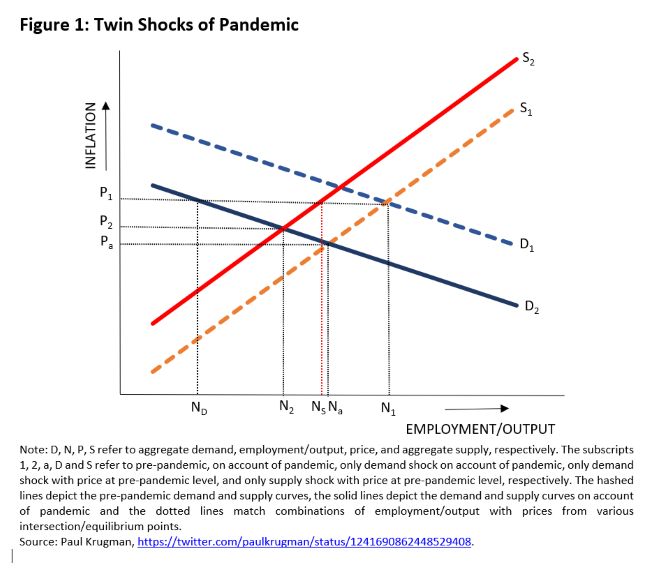
By Srijit Mishra
The World Health Organisation characterised Covid-19 as a pandemic on March 11, 2020 and in a little over three months, as per the situation report of June 15, 2020, the disease has impacted 216 countries, areas or territories with 80,35,364 confirmed cases and 4,36,918 deaths of which India has 3,54,161 confirmed cases and 11,922 deaths. The World Bank’s Global Economic Prospects, June 2020 indicates a global contraction by −5.2 per cent in 2020, the worst recession since World War II, with the decline in India estimated at −3.2 per cent.
At the global level, the pandemic has been handled reasonably well by New Zealand, South Korea, Taiwan, and Vietnam and in India there has been some success in the states of Assam, Chhattisgarh, Kerala, and Odisha. The initial thrust to save lives in these countries/states has been possible by being proactive, as against being reactive, and many other country- or state-specific initiatives. The challenges surmount, as the danger from the pandemic is still there, and we are now faced with the task of reviving livelihoods and to get the economy back on its feet.
Twin shocks and need for stimulus
While acknowledging the complexities of the economy and the uncertainty brought in by the pandemic, in simple terms, the recession is because of twin negative shocks with both aggregate demand and aggregate supply shifting to their left (see Figure 1). Now, if there is some inflation targeting and prices remain the same then, as Paul Krugman puts it, there is an inevitable employment/output loss (N1 to NS) on account of shift in supply (closing down of non-essential services), and an avoidable employment/output loss (NS to ND) if efforts are not in place to address the shift in demand.
READ I Power Webinar Series: Handholding India’s struggling MSMEs back to recovery
An alternative explanation, that may somewhat explain the Indian condition is that the strict lockdown led to an shift in demand leading to fall in employment/output and prices (from (N1,P1) to (Na,Pa); like the scenario immediately after lockdown), and a somewhat lagged shift in supply leading to a further fall in employment/output but some recovery in prices (from (Na,Pa) to (N2,P2); like the scenario a fortnight after lockdown). Immediately after the lockdown, in addition to efforts by the state, there have been initiatives by some non-state actors to minimize avoidable loss (no retrenchment and distribution of food and other essentials among others), but their continuation for longer periods becomes difficult during a recession.

There is a need for stimulus that address the twin shocks, with an emphasis on minimizing avoidable loss that is inclusive and does not exclude those who are vulnerable. However, the revival packages are largely focusing on the supply side. For instance, the bulk of 20 lakh crore rupees Atma Nirbhar Bharat package is to lift the supply side by infusing more liquidity in the economy and to facilitate credit with some sovereign guarantees for micro, small and medium enterprises (MSMEs) as also agriculture and allied activities, among others. At the same time, the components in the package for the demand side has largely been an additional budgetary grant of 40,000 crore rupees towards schemes under Mahatma Gandhi National Rural Employment Guarantee Act (MGNREGA) and some other initiatives including those that had already been incurred. Besides the anomaly of a greater focus on supply side, this approach also seems to jump over the need to revive livelihoods and also the continuing threat on life.
Revival package: Some suggestions
It is true that the stimulus package for India has credit plans for MSMEs as also agriculture and allied activities and that along with schemes under MGNREGA should address some livelihood requirements. While appreciating the intentions, let us look at possible concerns and provide some suggestions on each of these.
For MSMEs, a unit will revive production if the entrepreneur foresees a demand, otherwise she risks non-serviceability of existing and additional debt burden. Even where the entrepreneur wants to restart, the difficulty is that her units are in one state (Delhi, Gujarat, Maharashtra and Tamil Nadu) while the workers are from different states (Bihar, Madhya Pradesh, Odisha, Uttar Pradesh) where they have recently returned through a painful journey and they may not want to go back to the same work sites if they are provided with opportunities nearer home. Now, if new units come up near the worker’s home, the recent experience of units closing down and not opening up when required would force many existing as also new entrepreneurs to mechanize their units and move towards Industry 4.0 such that, in another six months to two years, their requirement of labour will shift to fewer ones with a different skill set. Further, in the absence of security of tenure, made worse by the recent ordinances in some states, it is not sure how many of them will get their jobs back. Having said that, I would suggest that there is a need to leverage and synchronize the credit schemes to set up unit’s closer to where workers are and to also come up with enterprises that provides greater livelihood opportunities.
READ I Repeating history: Lessons from 1994 plague for India’s fight against Covid-19
On agriculture, we seem to be ignoring that there has been an ongoing crisis that has been there for nearly two decades. This has largely been on account of an input-intensive credit-dependent system. So much so that agriculture is perhaps the only enterprise where a loan is taken to continue doing the same thing again and again, year after year, as against normal entrepreneurial venture of taking loans to expand either vertically or horizontally. This limitation of an agricultural crop loan is a failure of knowledge, practice and policy. This has come out of a focus on productivity that not only ignored livelihoods linked to agriculture, but also forced us into silos that failed to see the interdependence between plants, animals, soils and humans (not to forget the zoonotic origin of the current pandemic). Unfortunately, these have been pushing the farmer, and now even the farm worker, to death by suicide.
The United Nations in a recent policy brief, as also in a report by World Food Programme, have pointed out an impending global food emergency and that the number of people facing acute food insecurity or worse will nearly double from 1.35 crore in 2019 to 2.65 crore by the end of 2020. Concurrently, the Food and Agriculture Organization has also come out with a policy brief pointing out the relevance of diet and nutrition to strengthen immunity, more so during a pandemic. Further, the continuing nature of the pandemic has also brought in an uncertainty and we do not know when we would be in a containment zone. Given these, it is imperative to reduce weather, market or other non-market risks to the farmer and expand the areas under sustainable agriculture through an agro-ecological approach. This requires some knowledge-based intervention and not the usual credit push. There are many successful experiences in India like the Andhra Pradesh Zero Budget Natural Farming (APZBNF) or the Odisha Millets Mission OMM among others. In fact, the National Institution for Transforming India (NITI Aayog) has also mentioned about the advantage of these in the recent past. In line with this, an interdependent sustainable food system that is developed through supply chains from village upwards to urban centres will also open up many forward and backward linkages.
An additional budget provision to schemes under MGNREGA is a welcome step. However, there is a need to synchronize this with rural assets, particularly those that will help in strengthening sustainable agriculture, which also has a lot of potential in providing additional employment. Besides, we could consider providing the wages under MGNREGA even when the person concerned works in her own farm, a positive lesson from Maharashtra’s employment guarantee prior to MGNREGA through convergence with other schemes, to develop livelihoods. Similarly, if a person is made to work in community land or someone else’s land then the person should also have a right in the share of the produce. At the same time, some employment guarantee and security for the informal workers in urban areas would also help.
READ I Odisha’s quiet success in war on Covid-19 pandemic
Conclusion
There are two important lessons that the pandemic has taught us. On the one hand, it points out the importance of health, and also perhaps education, as public goods, and not as merit goods that are targeted for some. And, on the other hand, it indicates that global best practices need to be modified for local requirement, particularly relevant when it comes to saving lives and reviving livelihoods. This means that local bodies and states need to come up with schemes of their own, but then their funds are limited. It calls for greater fund flow with broad guidelines, but not by tying them up to a one-size fits all. There is also a need to strengthen revenue earning capacities of local bodies, which perhaps is also in line with the suggestions by the Fifteenth Finance Commission. Further, taking a fig leaf from the United States, the centre and states need to engage and provide constitutional remedies wherein local bodies as also states also have the right to levy additional direct taxes and also have other avenues for earning revenue.
To sum up, a response to the pandemic should follow a path of life, livelihood and economy. First, we need to save lives. Subsequently, to address livelihood concerns the focus should be on the demand side through strengthening sustainable agriculture with forward and backward linkages, and on providing an enabling environment for MSMEs that synchronize the need of workers and entrepreneurs. It is only when lives are saved and their livelihoods are set in motion that the supply side interventions would help in strengthening the post-pandemic economy, which is also inclusive.
(Srijit Mishra is Director, Nabakrushna Choudhury Centre for Development Studies (NCDS) and Professor (on Leave), Indira Gandhi Institute of Development Research (IGIDR), Mumbai. The views expressed are that of the author and do not represent the views of the organisations that the author is affiliated to or is associated with.)
